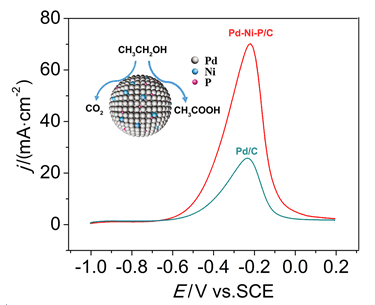| [1] Antolini, E.; Gonzalez, E. J. Power Sources 2010, 195, 3431.
[2] Rabis, A.; Rodriguez, P.; Schmidt, T. J. ACS Catalysis 2012, 2, 864.
[3] Xie, S.-W.; Chen, S.; Liu, Z.-Q.; Xu, C.-W. Int. J. Electrochem. Sci 2011, 6, 882.
[4] Wang, Y.; Zou, S.; Cai, W.-B. Catalysis 2015, 5, 1507.
[5] Bianchini, C.; Shen, P. K. Chem. Rev. 2009, 109, 4183.
[6] Antolini, E. J. Power Sources 2007, 170, 1.
[7] Demirci, U. B. J. Power Sources 2007, 173, 11.
[8] Kitchin, J. R.; Nørskov, J. K.; Barteau, M. A.; Chen, J. Phys. Rev. Lett. 2004, 93, 156801.
[9] Liu, P.; Nørskov, J. K. Phys. Chem. Chem. Phys. 2001, 3, 3814.
[10] Vigier, F.; Coutanceau, C.; Hahn, F.; Belgsir, E.; Lamy, C. J. Electroanal. Chem. 2004, 563, 81.
[11] Yajima, T.; Uchida, H.; Watanabe, M. J. Phys. Chem. B 2004, 108, 2654.
[12] Wang, Y.; Shi, F.-F.; Yang, Y.-Y.; Cai, W.-B. J. Power Sources 2013, 243, 369.
[13] Jiang, R.; Tran, D. T.; McClure, J. P.; Chu, D. ACS Catal. 2014, 4, 2577.
[14] Chen, L.; Lu, L.; Zhu, H.; Chen, Y.; Huang, Y.; Li, Y.; Wang, L. Nat. Commun. 2017, 8, 14136.
[15] Qi, Z.; Geng, H.; Wang, X.; Zhao, C.; Ji, H.; Zhang, C.; Xu, J.; Zhang, Z. J. Power Sources 2011, 196, 5823.
[16] Ahmed, M. S.; Jeon, S. ACS Catal. 2014, 4, 1830.
[17] Ma, L.; He, H.; Hsu, A.; Chen, R. J. Power Sources 2013, 241, 696.
[18] Du, W.; Mackenzie, K. E.; Milano, D. F.; Deskins, N. A.; Su, D.; Teng, X. ACS Catal. 2012, 2, 287.
[19] Mao, H.; Wang, L.; Zhu, P.; Xu, Q.; Li, Q. Int. J. Hydrogen Energy 2014, 39, 17583.
[20] Huang, M.-H.; Jin, B.-Y.; Zhao, L.-H.; Sun, S.-G. Acta Phys.-Chim. Sin. 2017, 33, 563(in Chinese). (黄明辉, 金碧瑶, 赵莲花, 孙世刚, 物理化学学报, 2017, 33, 563.)
[21] Tao, X.; Li, L.; Qi, X.; Wei, Z. Acta Chim. Sinica 2016, 75, 237(in Chinese). (陶熊新, 李莉, 齐学强, 魏子栋, 化学学报, 2016, 75, 237.)
[22] Lai, Q.-Z.; Yin, G.-P.; Wang, Z.-B. J. Chem. Eng. Chin. Univ. 2009, 23, 756(in Chinese). (赖勤志, 尹鸽平, 王振波, 高校化学工程学报, 2009, 23, 756.)
[23] Wang, N.; Zhang, W.; Wang, Y.-X. Chem. Ind. Eng. 2017, 34, 80(in Chinese). (王娜, 张文, 王宇新, 化学工业与工程, 2017, 34, 80.)
[24] Wang, J.-Y.; Kang, Y.-Y.; Yang, H.; Cai, W.-B. J. Phys. Chem. C 2009, 113, 8366.
[25] Yang, G.; Chen, Y.; Zhou, Y.; Tang, Y.; Lu, T. Electrochem. Commun. 2010, 12, 492.
[26] Mao, X. Y.; Liang, X. P.; Liu, J.; Liu, L.; Liu, K. Key Eng. Mater. 2014, 633, 330.
[27] Dutta, A.; Datta, J. J. Phys. Chem. C 2012, 116, 25677.
[28] Yin, J.; Shan, S.; Ng, M. S.; Yang, L.; Mott, D.; Fang, W.; Kang, N.; Luo, J.; Zhong, C. J. Langmuir 2013, 29, 9249.
[29] Mao, H.; Huang, T.; Yu, A. S. J. Mater. Chem. A 2014, 2, 16378.
[30] Li, L.; Chen, M.; Huang, G.; Yang, N.; Zhang, L.; Wang, H.; Liu, Y.; Wang, W.; Gao, J. J. Power Sources 2014, 263, 13.
[31] Huang, Z.; Zhou, H.; Li, C.; Zeng, F.; Fu, C.; Kuang, Y. J. Mater. Chem. 2012, 22, 1781.
[32] Shen, S.; Zhao, T.; Xu, J.; Li, Y. J. Power Sources 2010, 195, 1001.
[33] Wakisaka, M.; Mitsui, S.; Hirose, Y.; Kawashima, K.; Uchida, H.; Watanabe, M. J. Phys. Chem. B 2006, 110, 23489.
[34] Wang, J.-Y.; Zhang, H.-X.; Jiang, K.; Cai, W.-B. J. Am. Chem. Soc. 2011, 133, 14876.
[35] Rodriguez, P.; Kwon, Y.; Koper, M. T. Nat. Chem. 2012, 4, 177.
[36] Yang, Y.-Y.; Ren, J.; Li, Q.-X.; Zhou, Z.-Y.; Sun, S.-G.; Cai, W.-B. ACS Catal. 2014, 4, 798. |
